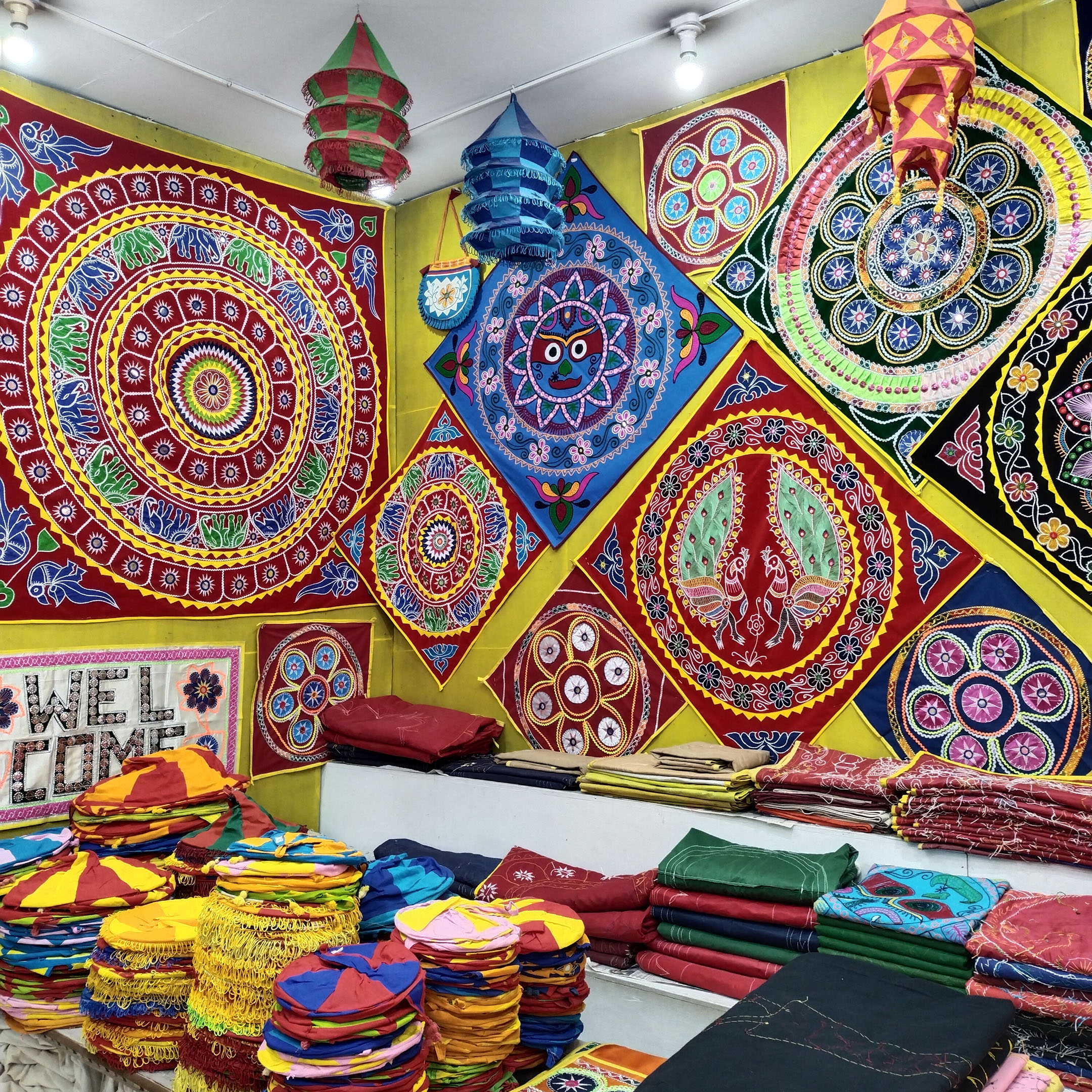Happy New year 2022, folks! How have all of you been this new year? Things have been very hectic on my side with a big change in my job front with a lot of administrative responsibilities. Thus, it seems like ages ago that I visited Orissa even though it was just a week ago. It was during that visit to Puri, I visited the famous Pipli village to see Pipili appliqué work. Appliqué is the application of bits of fabrics, ribbons and laces on a textile surface. It could be further ornamented with buttons, mirrors and embroidery stitches. In Pipli, one can come across rows of shops selling the appliqué work that could be both hand and machine made. Even when sewing machines are used to create the machine appliqué, the placement and maneuvering of components is done by hand.
Traditionally, appliqué was done to ornament canopies and banners at the Puri Temple. However, at the present in addition to the holy uses of the craft, the techniques are used to create personal accessories like bags and home decor objects such as lamp shades, decorative umbrella, banners (torans), bed covers, letter cases, cushion covers, and tapestries. Do check out D’source to see the making process.

Origins of Pipili Appliqué
Historically, appliqué craftsmen made canopies, banners, umbrellas and trasa (fans) for festivals held at the Puri Jagannath temple. The then king of Puri, setup a villiage for the craftspeople about 40km from Puri, known as Pipli where they could live and work. Work at Pipli village reaches a feverish pitch when they set out to prepare the famous chandua or canopy- canvas cloth that is used to cover the chariots of Lord Jaganath, Lord Balabhadra and Devi Subhadra during the annual temple car festival or Ratha yatra. For more information on the craft, please read this document by Bonani Samall.

Embroidery Stitches in Pipili Appliqué
Since the craft takes various forms at the present, its visuality include the use of several embroidery stitches. The most common are the stem stich, button hole (straight and round to secure mirrors), running stitch, chain stitch and stitches used in hemming. There is also a interesting stich called Kitikitia. This stitch is a variation on the button-hole stitch. Here, after two regular stitches, one half-stitch is used. There is a combination of floral, geometric, as well animal and abstract motifs in the appliqué.

Types of ‘Pattis’ in Pipili Appliqué
Patti is typically a border or a lengthwise patch. There are several kinds of borders and patches used to the banners and home decor products.
1. Phula patti (flower motif): black background with flowers in red, yellow, white, and green.
2. Sadha patti or naali patti (plain red strip): always red background with designs in yellow and black.
3. Nahara patti (right-facing cone pattern): white, red, and black combination.
4. Kalaso patti (pitcher strip): black background, white pitcher pattern.
5. Beliri patti (strip from left to right): white and red strip.
6. Mooda patti (strip from right to left): using white, red, and black or blue colours
7. Gula patti (wavy strip): black background, chain stitch with red or white thread.
8. Chaina patti (strip of embroidered patterns in chain stitch).
9. Khandiyali patti (diamond-shaped strip): red and black square (chauka) pania (triangular strip on top and bottom edge) cloth.
10. Chauka patti (square strip): background of black and blue, with white chain stitch
11. Sua patti (peacock strip): background of red with green.
12. Hansa patti (swan strip): black background, with red and yellow hansa.

Pipili market
There is a long street in Pipli village which is the crafts market. There are shops on either side selling colour products and you can compare prices and products between shops before buying them. The hanging on the extreme right in the image above is old and traditional. The ones on the left are more popular with tourists as they combine both machine work – as in assembly of patches and hand work – embroidery and mirrorwork. they can also be folded like a umbrella and hence easy to carry. The bags in the center are mass produced with machine embroidery, cheap, and are available throughout India. I am unsure as to if they are really made in Pipli or even in India for that matter.
Several store owners store their surplus stock at home and will invite you to see it. It is alright to go, provided you are aware of what you want to buy and are not compelled to buy something that you do not want. You can visit the Government emporium first to know the standard prices set for each category of object. However, prices will vary based on the size, intricacy of the work and the functionality of the product. Take a walk with me through the Pipli market through this reel on my JewelsofSayuri Instagram page.
View this post on Instagram
Over the last few years, I have had several people tell me that I must visit Orissa and that I would love the crafts there. The three short days that I had in Bhubaneshwar and Puri allowed me a glimpse of that famed craft culture that left me longing for me. With that said, I wrap up my posts on the craft of Pattachitra and Pipli applique. I hope you enjoyed reading them. I want to write about a fabulous Tribal museum that I visited in Bhubaneshwar where I saw a hall full of ethnic jewellery. I aim to write about it soon.
Until then, tell me how your New year has been and your goals for this year.
I hope you find it interesting
Cheers



What do you think?